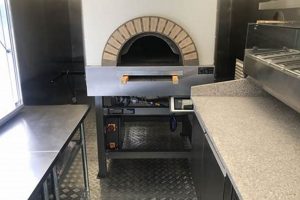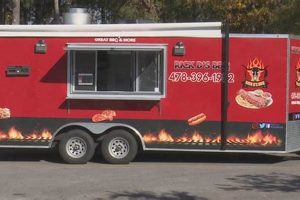Securing monetary resources for the acquisition, outfitting, and operation of a mobile culinary business is a critical step for aspiring entrepreneurs in the food service industry. These funds can cover expenses such as the purchase of the vehicle, installation of kitchen equipment, permits, licenses, initial inventory, and marketing costs. For example, a loan can enable an individual to transform a basic truck chassis into a fully functional, health-code-compliant kitchen on wheels.
Access to capital is paramount to the establishment and subsequent growth of this type of venture. The availability of funds can significantly impact the entrepreneur’s ability to procure necessary equipment, navigate regulatory hurdles, and effectively market their product. Historically, gaining access to traditional lending sources has been challenging for mobile food businesses, leading to the development of specialized financial products and services designed to address their unique needs.
The following sections will delve into the diverse array of funding options available, the factors lenders consider when evaluating applications, and strategies for maximizing the chances of approval. A comprehensive understanding of these elements is essential for anyone seeking to launch or expand a mobile food vending operation.
Tips on Acquiring Funds for Mobile Culinary Ventures
Effective navigation of the capital acquisition process for mobile food businesses necessitates meticulous planning and a thorough understanding of lender requirements. The following guidelines are designed to improve the likelihood of securing necessary financial resources.
Tip 1: Develop a Comprehensive Business Plan: A well-articulated business plan serves as a roadmap for the venture and demonstrates preparedness to potential lenders. This document should include a detailed market analysis, projected financial statements, and a clear explanation of the business’s competitive advantage.
Tip 2: Establish a Strong Credit History: Lenders place significant emphasis on an applicant’s creditworthiness. Maintaining a strong credit score and a history of responsible debt management are crucial. Prior to applying for funds, obtain a credit report and address any inaccuracies or outstanding debts.
Tip 3: Explore Diverse Funding Sources: Do not limit the search to traditional bank loans. Consider alternative options such as Small Business Administration (SBA) loans, crowdfunding platforms, microloans, and equipment leasing. Each source has its own eligibility criteria and terms.
Tip 4: Prepare Detailed Financial Projections: Lenders require a clear understanding of the business’s potential profitability. Provide realistic and well-supported financial projections, including revenue forecasts, expense budgets, and cash flow statements. Substantiate these projections with market research and industry data.
Tip 5: Secure Collateral or Offer a Personal Guarantee: Providing collateral, such as personal assets, or offering a personal guarantee can increase the likelihood of approval. This demonstrates a commitment to the business’s success and reduces the lender’s risk.
Tip 6: Research and Compare Lending Terms: Interest rates, repayment schedules, and fees can vary significantly between lenders. Carefully compare the terms of different offers to identify the most favorable option. Pay close attention to any prepayment penalties or hidden costs.
Tip 7: Maintain Accurate and Organized Records: Lenders will scrutinize the business’s financial records. Maintaining accurate and organized records of income, expenses, and assets demonstrates financial responsibility and transparency.
Adherence to these recommendations can significantly enhance the chances of successfully acquiring the resources necessary to launch and operate a thriving mobile food business. A proactive and well-prepared approach is essential for navigating the complexities of the capital acquisition process.
The subsequent sections will examine specific types of lenders and the application process in greater detail.
1. Credit Score
A credit score serves as a critical indicator of an applicant’s financial responsibility and creditworthiness, profoundly impacting their ability to secure resources for a mobile food truck business. Lenders utilize this score to assess the risk associated with extending credit, and it significantly influences the terms offered.
- Credit Score as a Risk Assessment Tool
Lenders employ credit scores to gauge the likelihood of repayment. A higher score suggests a lower risk of default, leading to more favorable terms, such as lower interest rates and larger loan amounts. Conversely, a lower score indicates a higher risk, potentially resulting in higher interest rates, stricter repayment terms, or denial of the application. For example, an applicant with a credit score of 750 may qualify for a loan with a 6% interest rate, while an applicant with a score of 620 might face an interest rate of 12% or higher.
- Impact on Loan Terms and Availability
The credit score not only affects the interest rate but also influences the overall availability of financing. Some lenders may have minimum credit score requirements that applicants must meet to be considered. Furthermore, the loan amount and repayment terms can be directly tied to the credit score. Applicants with excellent credit may be eligible for larger loans with extended repayment periods, while those with poor credit may be limited to smaller loans with shorter terms. This can impact the ability to purchase necessary equipment or cover operational expenses.
- Influence on Alternative Lending Options
While traditional bank loans are heavily reliant on credit scores, alternative lending options, such as online lenders and peer-to-peer platforms, may also consider this factor, although perhaps with less emphasis. Even when alternative lenders are more lenient regarding credit scores, they often compensate for the increased risk by charging higher interest rates or fees. Consequently, a low credit score can still limit access to affordable financing options and increase the overall cost of acquiring resources.
- Rebuilding Credit Before Applying
Given the significant impact of the credit score, it is often advisable for aspiring food truck entrepreneurs with low scores to prioritize rebuilding their credit before applying for resources. This can be achieved through strategies such as paying down outstanding debts, correcting errors on credit reports, and establishing a positive payment history. Improving the credit score, even incrementally, can substantially increase the chances of approval and secure more favorable loan terms, ultimately contributing to the long-term financial health of the business.
In summary, the credit score acts as a gatekeeper to funding for mobile culinary ventures. A higher score translates to increased accessibility, favorable terms, and reduced financial burden, while a lower score can present significant obstacles and increase the overall cost of capital. Therefore, proactive management and improvement of creditworthiness is a critical step in the process of securing the resources necessary for a successful mobile food truck operation.
2. Business Plan
A well-developed business plan is an indispensable tool in the context of securing funding for a mobile food truck venture. It serves as a formal document outlining the objectives, strategies, and financial projections of the business, providing potential lenders with a comprehensive overview of its viability and potential for success. Its absence or inadequacy often results in denial of financing requests, underscoring its importance in the financial acquisition process. For example, a detailed market analysis within the plan can demonstrate a thorough understanding of the target customer base, competitive landscape, and demand for the proposed food offerings, increasing lender confidence in the business’s revenue projections.
The business plan acts as a blueprint for operational efficiency and fiscal responsibility. It facilitates a clear articulation of the financial needs, detailing the required capital for truck acquisition or leasing, equipment purchases, initial inventory, permits, and ongoing operating expenses. Furthermore, it presents projected income statements, balance sheets, and cash flow statements, allowing lenders to assess the business’s capacity to generate revenue, manage expenses, and repay debt obligations. Consider a scenario where a plan includes a detailed marketing strategy with projected customer acquisition costs; this can reassure lenders that the business has a plan to attract and retain customers, leading to stable income.
In summary, the business plan is not merely a formality but a foundational element for securing resources for a mobile food truck operation. It demonstrates preparedness, provides a framework for financial management, and builds confidence with potential lenders. Addressing challenges such as fluctuating food costs and unexpected repairs within the plan showcases realistic foresight. By effectively articulating the business’s vision, strategy, and financial prospects, the business plan significantly improves the chances of obtaining the necessary resources to transform a culinary dream into a thriving mobile enterprise, aligning perfectly with the broader theme of entrepreneurial success through strategic planning.
3. Down Payment
A down payment represents an initial sum of capital contributed by the borrower towards the purchase of an asset, in this context, a mobile food truck or related equipment. Its significance in facilitating food truck financing lies in its direct correlation with the lender’s perceived risk. A substantial down payment reduces the loan amount required, thereby lowering the lender’s exposure to potential losses in the event of default. For instance, if an aspiring food truck operator aims to acquire a vehicle valued at $50,000, a down payment of $10,000 reduces the loan requirement to $40,000, making the application more attractive to lending institutions.
The impact of the down payment extends beyond simply reducing the loan principal. A larger down payment often translates to more favorable loan terms, including lower interest rates and reduced fees. This is because the lender perceives the borrower as having a greater vested interest in the success of the business, leading to a higher likelihood of repayment. Furthermore, demonstrating the capacity to accumulate a sizable down payment signals financial discipline and responsible money management, further enhancing the borrower’s credibility. A business with a 20% down payment on equipment may negotiate a significantly lower interest rate than one with only a 5% down payment, resulting in substantial long-term savings. This financial prudence often convinces investors more.
In conclusion, the down payment is not merely a preliminary expense but a critical component that influences the availability and affordability of resources. It serves as a tangible demonstration of the borrower’s commitment, reduces the lender’s risk exposure, and often unlocks more favorable loan terms. Overcoming the challenge of accumulating a sufficient down payment requires careful financial planning and potentially exploring alternative funding sources, yet the long-term benefits associated with securing more advantageous financing make it a worthwhile endeavor for aspiring mobile food entrepreneurs, directly influencing their business’s sustainability.
4. Loan Type
The selection of an appropriate loan type is a pivotal determinant in the successful acquisition of resources for a mobile food truck enterprise. The loan type fundamentally shapes the terms, accessibility, and long-term financial implications of the funding obtained. A mismatch between the loan type and the specific needs of the business can result in financial strain, hindering growth or even leading to failure. For example, a secured loan, while potentially offering lower interest rates, requires collateral that the business owner may not possess, whereas an unsecured loan, though more accessible, typically carries higher interest rates, increasing the overall cost of capital.
Various loan types cater to the distinct requirements of mobile food businesses. SBA loans, backed by the Small Business Administration, often provide favorable terms and lower interest rates, but necessitate a rigorous application process and may require a personal guarantee. Equipment financing is specifically designed for acquiring essential kitchen equipment and vehicles, often using the purchased asset as collateral. Term loans offer a fixed sum of money with a predetermined repayment schedule, providing predictability in budgeting. Lines of credit offer flexibility for managing fluctuating cash flow needs, allowing the business to draw funds as required up to a certain limit. The impact of the loan structure is direct; a well-structured loan can enable sustainable growth, while an ill-suited loan can lead to cash flow problems and impede operations.
Therefore, the selection of a suitable loan type warrants careful consideration of the business’s financial situation, asset availability, and projected revenue streams. Each loan type presents its own advantages and disadvantages, and a thorough comparison of terms, interest rates, and repayment schedules is essential. For instance, a start-up may benefit from a microloan with flexible repayment terms, while an established business seeking to expand its fleet may opt for equipment financing. Ultimately, the choice of loan type significantly impacts the accessibility, affordability, and long-term financial viability of the mobile food truck venture, highlighting its critical role in ensuring sustainable operational success.
5. Interest Rates
Interest rates represent a crucial cost component within the landscape of food truck financing. They denote the percentage charged by a lender above the principal amount borrowed, effectively determining the price of accessing capital. Interest rates are a primary factor influencing the total cost of resources, directly affecting the profitability and long-term financial viability of a mobile culinary enterprise. For example, a higher interest rate on a vehicle loan translates to increased monthly payments, which can strain cash flow and reduce funds available for operational expenses such as inventory, marketing, and maintenance.
The level of interest rates can fluctuate significantly based on several factors, including the borrower’s creditworthiness, the prevailing economic climate, and the specific type of resource instrument used. A borrower with a strong credit history typically qualifies for lower interest rates, reflecting a lower perceived risk by the lender. Conversely, a borrower with a less-than-ideal credit score faces higher interest rates, compensating the lender for the increased risk. Moreover, economic conditions such as inflation and market interest rate benchmarks influence the cost of capital. Considering a business obtaining equipment financing, a fixed interest rate provides predictable expenses, while a variable rate introduces uncertainty, with payments fluctuating based on market conditions.
Comprehending the interplay between interest rates and securing resources is imperative for informed decision-making in food truck financing. Entrepreneurs must diligently compare interest rates across various lending institutions and resource options to secure the most favorable terms. The ability to negotiate better interest rates, even by a small margin, can result in substantial savings over the loan’s lifetime, positively impacting the venture’s financial performance. The overall objective should be to minimize the cost of capital, ensuring the mobile food business can sustain profitability and achieve long-term success.
6. Repayment Terms
Repayment terms are a fundamental element of any food truck financing agreement. These terms dictate the schedule, method, and duration by which the principal amount of the borrowed funds, along with accrued interest, must be returned to the lender. Understanding and carefully considering repayment terms are paramount for aspiring mobile food entrepreneurs, as they directly impact cash flow, profitability, and long-term financial stability.
- Amortization Schedule
The amortization schedule outlines the periodic payments, typically monthly, required to repay the loan. It details the portion of each payment allocated to principal and interest. A longer amortization schedule results in lower monthly payments but increases the total interest paid over the life of the loan. Conversely, a shorter schedule entails higher monthly payments but reduces overall interest expenses. For instance, a five-year loan for $50,000 at 7% interest will have higher monthly payments than a seven-year loan at the same rate, but the total interest paid will be less. Choosing an appropriate amortization schedule requires careful consideration of the business’s projected cash flow and risk tolerance.
- Repayment Frequency
Repayment frequency refers to how often payments are made, usually monthly, but sometimes weekly or bi-weekly. More frequent payments can reduce the total interest paid and accelerate the loan payoff. However, they also require more diligent cash flow management. A food truck business with predictable daily sales may benefit from weekly payments, while a business with seasonal fluctuations may prefer monthly payments to better align with its revenue cycle. The selection of repayment frequency should synchronize with the business’s operational patterns and financial planning.
- Balloon Payments
A balloon payment is a large, lump-sum payment due at the end of the loan term. These payments can significantly reduce monthly obligations during the loan’s lifespan but pose a substantial financial risk if the business is unable to make the final payment. Balloon payments may be suitable for businesses anticipating a significant increase in revenue or a planned sale of assets before the loan matures. However, they require careful financial planning and a clear strategy for meeting the large final obligation.
- Prepayment Penalties
Prepayment penalties are fees charged by the lender if the borrower repays the loan before the agreed-upon schedule. These penalties are designed to protect the lender’s expected interest income. Understanding prepayment penalties is crucial, as they can limit the borrower’s flexibility to refinance the loan or pay it off early if the business experiences unexpected financial success. Negotiating for loans with no or minimal prepayment penalties can provide valuable financial agility.
The facets of repayment terms significantly impact the long-term sustainability of food truck ventures. Selecting appropriate terms necessitates a thorough evaluation of the business’s financial projections, risk appetite, and strategic goals. A well-structured repayment plan can facilitate manageable cash flow, minimize the total cost of capital, and contribute to the enduring success of the mobile food enterprise. Conversely, unfavorable repayment terms can create financial strain, impede growth, and increase the risk of default, emphasizing the critical nature of informed decision-making in this aspect of food truck financing.
7. Collateral
Collateral plays a significant role in securing monetary resources for a mobile culinary business. It represents assets pledged by the borrower to the lender, serving as security against the loan. In the event of default, the lender has the legal right to seize and liquidate the collateral to recoup losses. The presence and valuation of collateral directly influence a lender’s willingness to extend funds and impact the terms offered. For example, a newly acquired food truck itself can serve as collateral for an equipment loan, reducing the lender’s risk and potentially leading to a lower interest rate. The understanding of how collateral functions is crucial for food truck entrepreneurs seeking funding.
The specific types of assets that can be used as collateral in food truck financing are varied. Besides the food truck itself, other assets such as real estate, valuable equipment (ovens, refrigerators), and even accounts receivable can be considered. Lenders evaluate the market value, liquidity, and stability of the proposed collateral to assess its effectiveness as security. For instance, a lender might require a higher loan-to-value ratio for a piece of equipment that depreciates quickly compared to real estate that maintains its value. Accurate valuation of the collateral is, therefore, a critical step in the funding process. Furthermore, entrepreneurs should understand the implications of pledging personal assets as collateral, recognizing the potential for personal financial risk in case of business failure.
In summary, collateral acts as a cornerstone of food truck financing, mitigating lender risk and influencing loan accessibility and terms. The ability to offer suitable collateral can significantly improve the chances of securing funds, especially for start-up ventures lacking an established credit history. Challenges associated with collateral often involve accurate valuation and the willingness to pledge personal assets. The effective management of collateral considerations is essential for navigating the financial complexities of establishing and operating a successful mobile culinary enterprise, ultimately contributing to greater financial stability.
Frequently Asked Questions
The following addresses common inquiries regarding the acquisition of monetary resources for mobile food businesses. These questions and answers aim to provide clarity and guidance on navigating the financial aspects of launching and operating a food truck.
Question 1: What credit score is generally required to secure resources?
While specific requirements vary among lenders, a credit score of 680 or higher typically increases the likelihood of approval. Scores below this threshold may limit access to certain funding options or result in less favorable terms.
Question 2: What documents are typically needed for a food truck loan application?
Commonly required documents include a comprehensive business plan, financial statements (including profit and loss projections), personal and business tax returns, bank statements, and a list of assets to be used as collateral.
Question 3: Are SBA loans a viable option for food truck financing?
Yes, Small Business Administration (SBA) loans can be a viable option, offering favorable terms and lower interest rates. However, SBA loans often require a more rigorous application process and may necessitate a personal guarantee.
Question 4: What is equipment financing, and how does it work for food trucks?
Equipment financing is specifically designed for acquiring essential equipment, including the food truck itself. The equipment serves as collateral, and the loan is repaid over a set period. This type of financing is often easier to obtain than a general business loan.
Question 5: What are some alternative funding sources besides traditional bank loans?
Alternative funding sources include online lenders, microloans, crowdfunding platforms, and equipment leasing companies. These options may offer more flexibility but may also come with higher interest rates or fees.
Question 6: How can a food truck business improve its chances of loan approval?
Improving the chances of approval involves developing a solid business plan, maintaining a strong credit history, providing a substantial down payment, securing suitable collateral, and thoroughly researching and comparing different funding options.
Securing funding for a mobile food business requires careful planning, preparation, and a thorough understanding of the available options. Addressing these common questions can assist aspiring entrepreneurs in navigating the financial landscape.
The subsequent section will explore strategies for managing finances effectively once funding has been secured.
Food Truck Financing
This exploration has underscored the multifaceted nature of acquiring resources for mobile food ventures. Key elements, including credit scores, business plans, loan types, interest rates, repayment terms, and collateral, exert a substantial influence on the feasibility and affordability of food truck financing. A comprehensive understanding of these components is paramount for entrepreneurs seeking to navigate the financial landscape effectively.
The acquisition of funds is a critical determinant of success or failure. Prudent financial planning, strategic loan selection, and meticulous management of debt obligations are essential for long-term sustainability. Aspiring mobile food entrepreneurs are encouraged to approach this process with diligence and foresight, recognizing that sound financial practices are integral to transforming culinary aspirations into thriving enterprises.







